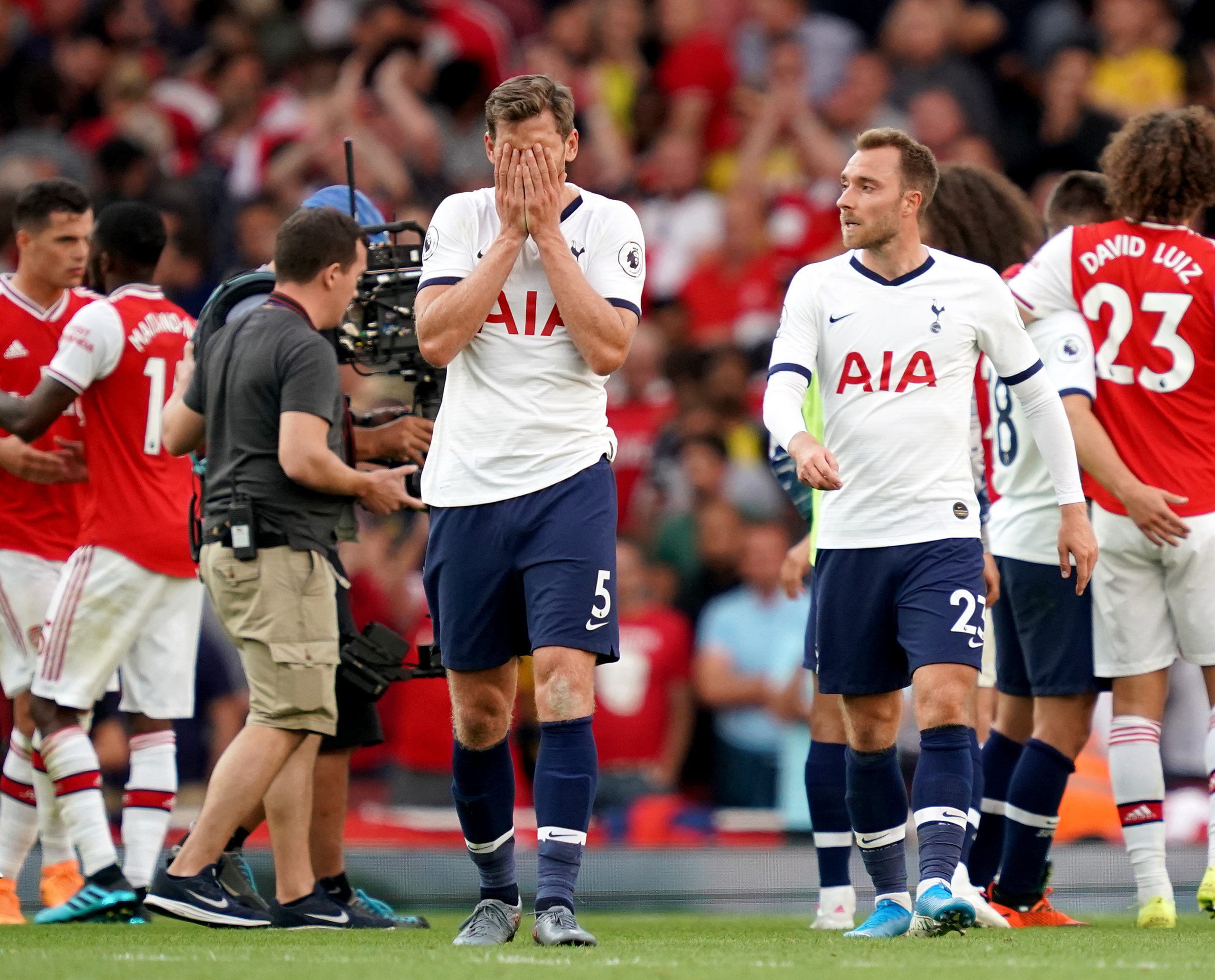Pierre-Emerick Aubameyang gets the equaliser and gives Spurs a whole international break of crisis narratives.
Tottenham sit ninth in the league table after four games and the talk is of “staleness”, and the possibility of Mauricio Pochettino and this team coming to the end of a cycle. Now, on the face of it, this could just be the fixture list. Draws away to Manchester City and Arsenal are not the end of the world, and Spurs beat Aston Villa in a fairly routine manner. Only the loss at home to Newcastle stands out as points obviously dropped. But to the eye and in the numbers there were clear issues at the Etihad and the Emirates that the results mask slightly, so let’s take a more in depth view of where Spurs are right now.
It was noted after the weekend’s defeat that Spurs conceded 56 shots to Arsenal and Manchester City combined (30 at the Etihad and 26 at the Emirates). That’s obviously a large number when you consider it’s more than any of Man City, Liverpool and Manchester United have conceded in all four of their league games so far. But how bad is it really? Is this not just an overreaction to two very difficult fixtures?
Not quite. Across the 2017/18 and 2018/19 seasons, Spurs did not have a single game in which they shipped 25 shots or more. The most was 23 away at Manchester United last season (in a game they won 3-0, because football is a funny old sport). That was their two year record and they’ve broken it twice before the first international break of the season.
Bleugh.
What solidifies the problem is that the xG per shot across the two games was a middling 0.1. These were not simply potshots against a team digging in and getting into a good shape behind the ball. There were some attempts from range, but also a decent chunk of high quality chances from good positions. One can’t really describe these defensive performances as anything other than awful.
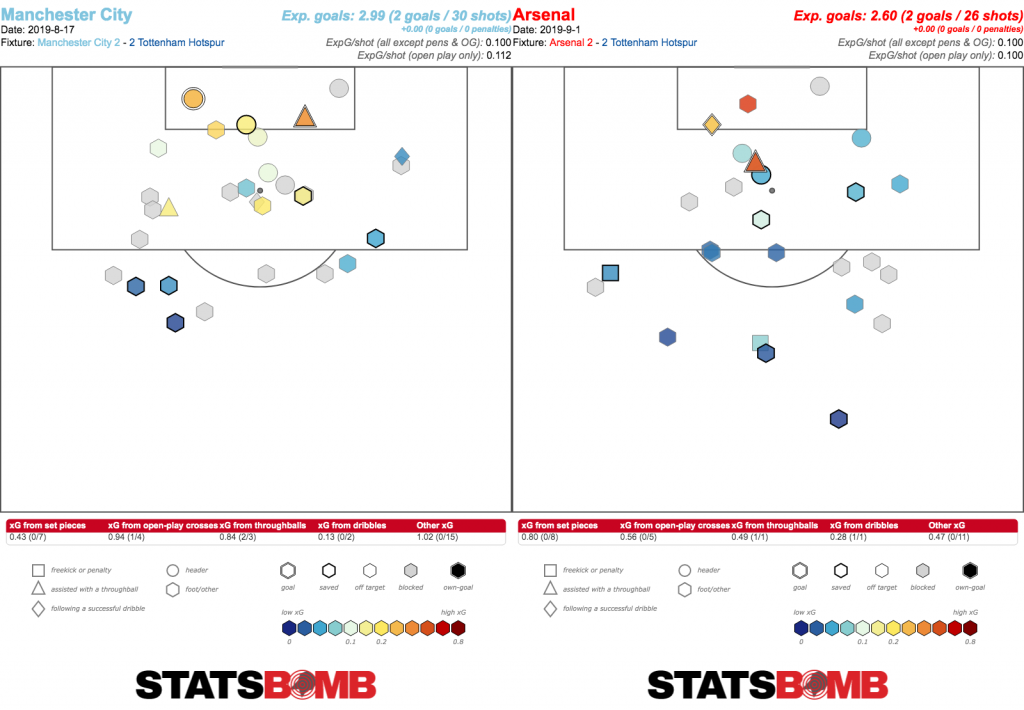
On the attacking side, things are a little more mixed. After a turgid opening period, Spurs created largely at ease in the second half against Villa, with everyone pointing toward Christian Eriksen’s 63rd minute introduction as the key turning point.

Pochettino employed close to the exact same approach against Newcastle, again bringing Eriksen on after an hour. It worked to an extent in that Spurs created more chances towards the game. Yes, you could argue that Tottenham would usually score a goal or two from those chances. But barely over one expected goal at home to Steve Bruce’s Newcastle is hardly something to celebrate.
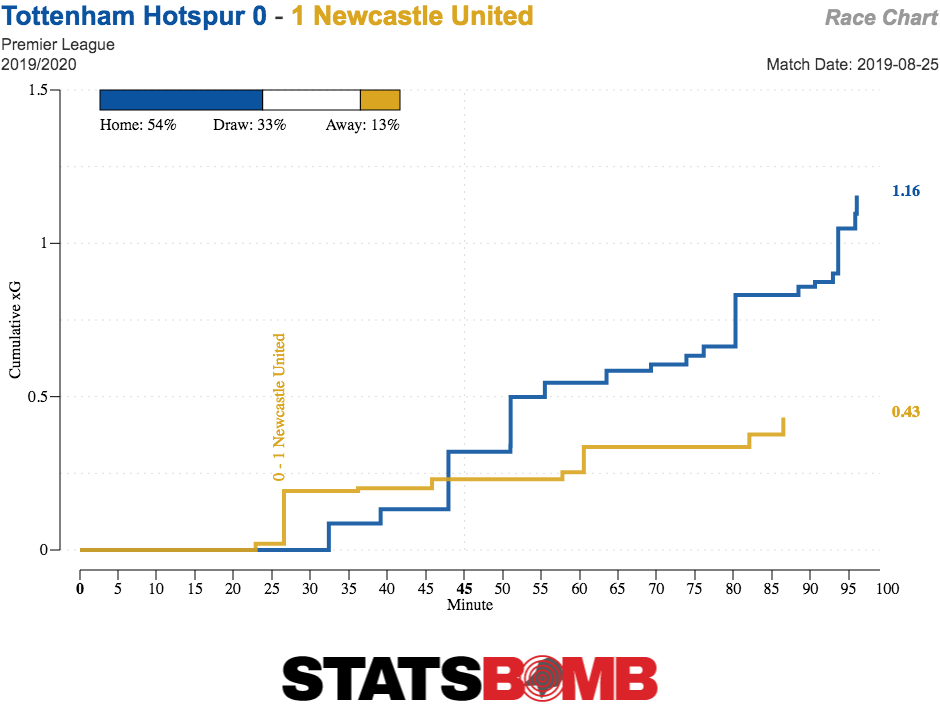
And as for the two big games, it’s something of a mixed bag. Spurs created essentially nothing against Man City. Three shots, two in City’s half, one in the box, somehow resulted in two goals. City can do that to you, but it’s somewhat concerning that Spurs created less against them than West Ham, Bournemouth and Brighton did. Against Arsenal things were a little better, but even then it was somewhat unbalanced. Spurs were able to pile up pressure on the hosts in the first half. Eriksen’s rebound goal was the one breakthrough from a number of productive attacking sequences. But the second half was a different story. After Arsenal equalised in the 70th minute, Spurs didn’t register a single shot until one added time attempt from Moussa Sissoko. The shot maps below, with Tottenham’s first half performance on the left and second half on the right, show how the team didn’t create much of note after the interval. Spurs have only had two halves this season of really impressive attacking play.
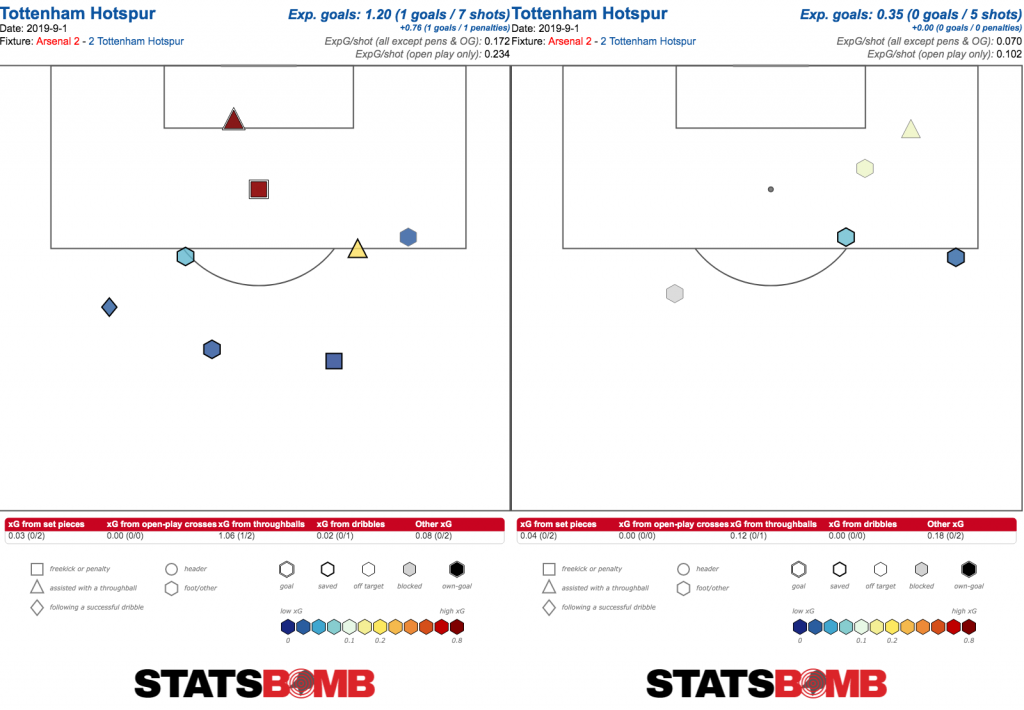
So we’ve established that Spurs haven’t been great so far this season. But it’s only a four game blip, right? They were good last season, weren’t they? They got to the Champions League final!
Well…
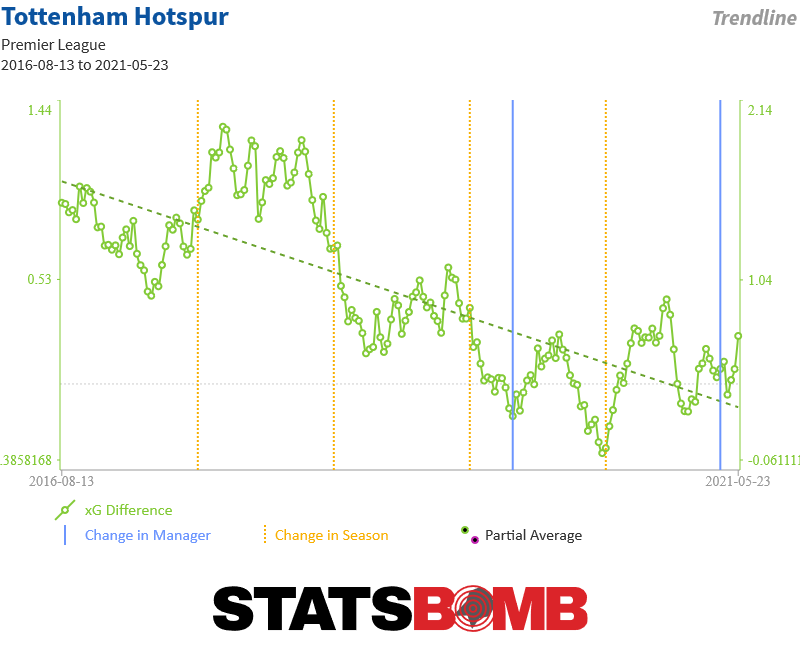
Tottenham’s metrics started trending downwards in early 2018 and never recovered. Results still held up in that calendar year, but it’s hard to put a positive spin on the league performance in 2019. Since the turn of the year, Tottenham have achieved 9 wins, 4 draws and 9 losses in the Premier League. Needless to say, a side that would like to consider itself among the best in a division should not be amassing as many losses as wins. And xG has Spurs scoring and conceding almost exactly as expected, so there are no get out of jail free cards there. This is a real issue of Spurs just not playing well for a long time.
The obvious issue last year was in central midfield. In previous seasons, Mousa Dembélé was a one man fix for any midfield control issues, certainly the best player in the Premier League at evading pressure and dribbling through a congested central area. His physical decline made him incapable of doing what he did so well, and thus he was sold. His most frequent midfield partner Eric Dier seemed to struggle badly without him, while Victor Wanyama was continually injured. Pochettino found some tactical tweaks to minimise the issue, but it’s still the most obvious cause for concern from last season.
It’s also something that should theoretically improve pretty much immediately after the international break. Tanguy Ndombele was signed to be the saviour of Tottenham’s midfield. Mousa Dembélé is the template, though the Frenchman is fitting into a slightly different role in a slightly different set up. Whereas Dembélé was generally complimented by Eric Dier, a converted centre back, or Victor Wanyama, a natural holding midfielder, it looks like Pochettino’s preferred pairing this year is Ndombele and Harry Winks. There’s a lot to like about this partnership in possession. Winks is developing into a high volume passer who can deliver the ball to more progressive zone movers, and Ndombele can then be the guy to really drive the ball forward into dangerous areas. Neither are specialist defensive midfielders, though both contribute a solid amount on that side of the ball. Whether this will be enough without the ball in tough fixtures is unclear. Dier remains an option in that regard though it’s been some time now since he regularly played well, while Wanyama is still on the books but perennially finds himself injured. Whether Spurs have totally “solved” the midfield isn’t fully clear, but it’s a very obvious upgrade on last season. When Ndombele returns to fitness, which is expected to be after the international break, Spurs should function much better in midfield than they have for over a year.
An issue that should now fix itself even easier is the lack of Eriksen. He’s staying. He’s a Tottenham player. Spurs’ worst attacking football has come when the Dane isn’t on the pitch, and he should be on the pitch a lot more going forward. Not only do they have him, but they have the player signed as his replacement, Giovani Lo Celso, and that should ensure that Tottenham don’t go too many more games without one of these two on the pitch. Lo Celso also offers a lot of tactical flexibility, able to play both the Winks and Ndombele roles as well as Eriksen’s, even if he was signed to play higher up the pitch. His long term destiny is likely to be The New Eriksen, but for now he’s a very useful depth piece.
It’s harder, though, to understand what the answers are at right back. Last season’s first choice option, Kieran Trippier, had his defensive limitations. And yet, much like a certain political issue, I am very much unconvinced that no right back is better than a bad right back. Kyle Walker-Peters seems to be the first choice, after starting all of four games last season. Whether he has done something to genuinely change Pochettino’s mind or it simply reflects a lack of real options is anyone’s guess, but my abiding memory of him so far this season is of Raheem Sterling going straight past him over and over again. Davinson Sánchez played the role in the North London derby and you probably already know how he did there. Looking at where Tottenham’s opponents have successfully managed to work the ball into the box (open play only), it’s hardly the only issue, but there’s certainly a strip where an excellent right back might be expected to clean things up a bit.
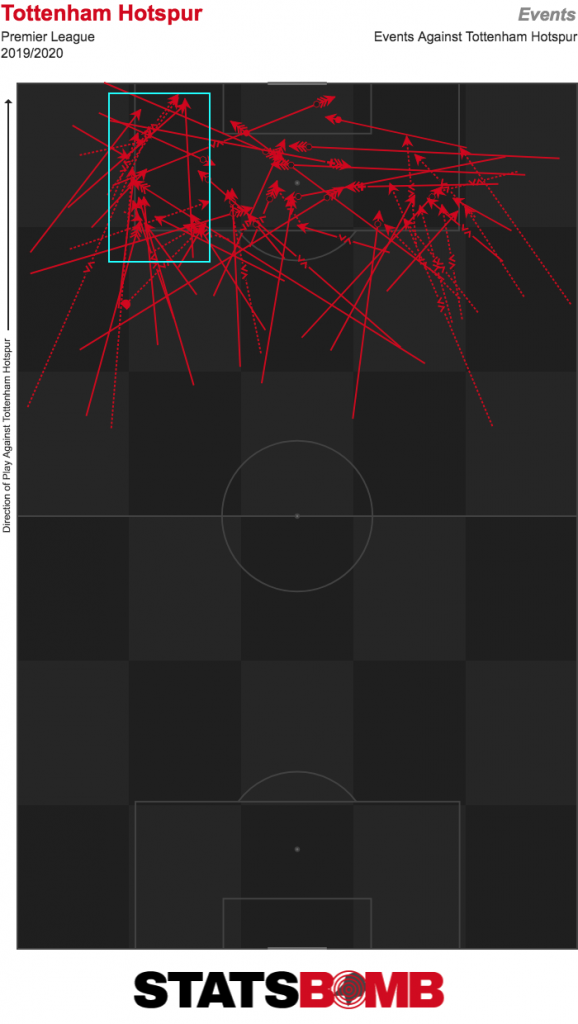
The biggest question for Tottenham is whether these issues are systemic or merely about personnel. I find it hard to believe that Pochettino’s tactical ideas suddenly stopped working after being so effective previously. There are noises that the dressing room isn’t quite as harmonious as it has been in the past, but this is the kind of speculation that can disappear with three wins. With the exception of right back, which the club inexplicably didn’t fix in the transfer market, easing up of injuries and more time for the new signings to integrate should improve things at Spurs significantly. Thus we should expect to see Tottenham’s form improve as the season goes on and likely they will retain their status as the third best team. Though this isn’t a certainty, and it might be worth checking in again later in the year, when we should have a better sense of how deep these problems really run.
